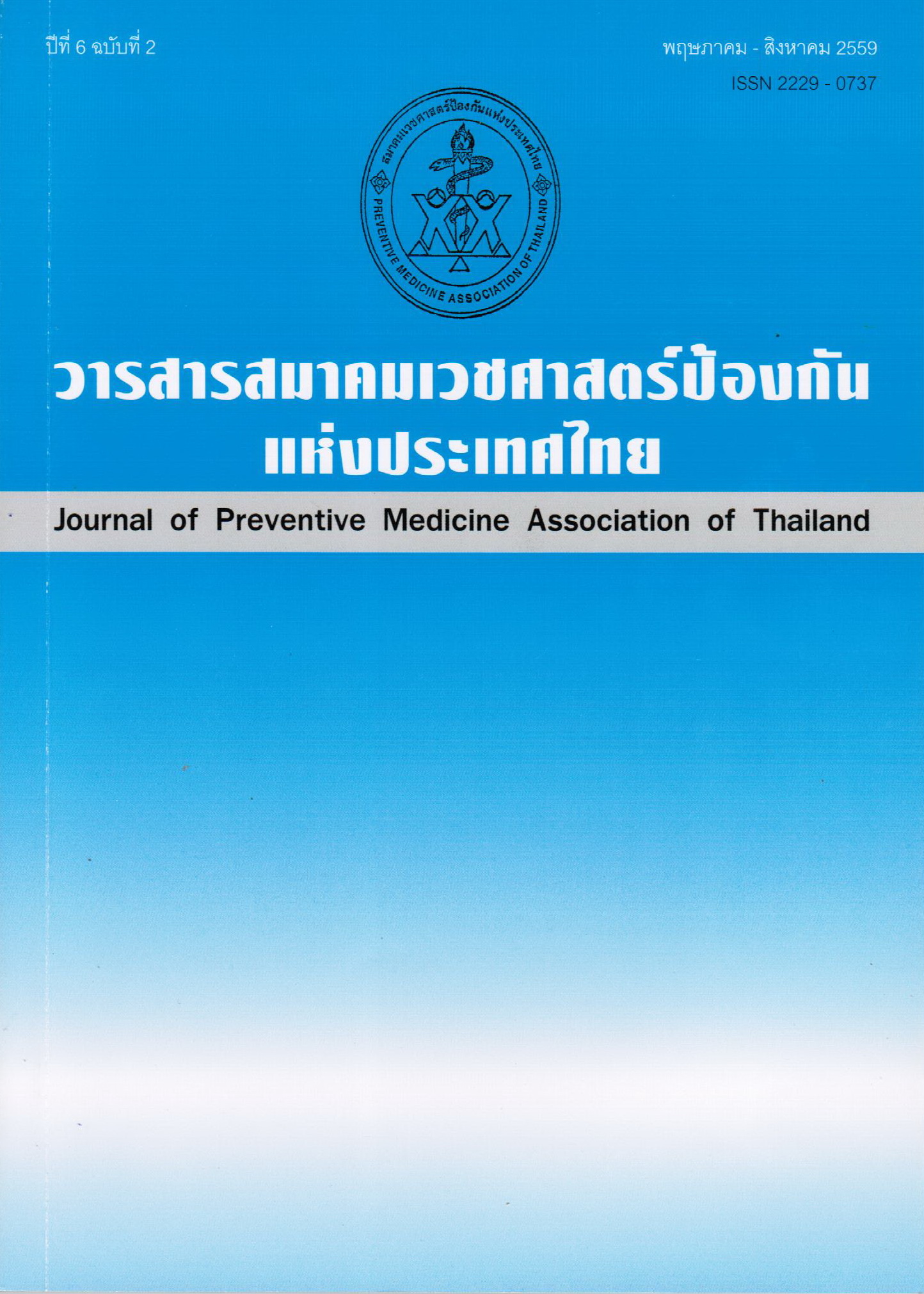A Model of Increasing Quality of Life Among Rural Aging in Sukhothai Province
Keywords:
Quality of life, elderly, rural areasAbstract
The objective of this study was to develop and examine the effectiveness of a model for developing quality of life among elderly in rural area. The study was conducted in 3 phases. The first phase aimed to assess factors associate with quality of life among elderly in rural area. The samples were 420 participants recruited by multistage random sampling. A questionnaire was administered by face to face interviews during December 2015 to March 2016; and analysis by Pearson’s product moment correlation coefficient. The result showed that such variables as age, income, knowledge, participation family activity, caring from family, health care system, basic human needed, environmental were associated with quality of life among elderly in rural area statistical significance. The second phase was to construct a model of develop quality of life among elderly in rural which consisted of the study on needs and quality of life suggested by stakeholders through five focus group discussions; and the content validity which was approved by five experts. The resulting model of develop quality of life among elderly consisted of 4 steps: (1) the learning aging and impact from aging; (2) learning skill participation family activity; and (3) the activities to self care behavior (4) the activities to environment conducive for life. The third phase was to evaluate effectiveness of a model for developing quality of life among elderly; and it was found that there was a significant increase in the average score of quality of life after the intervention (p<0.001). Therefore, this quality of life model should be applied and implemented for the elderly in rural areas.
References
2. วิทยาลัยประชากรศาสตร์. อนาคตประเทศไทยกับการก้าวเข้าสู่สังคมผู้สูงอายุ. (ระบบออนไลน์) 2553 (วันที่ค้นข้อมูล 12 เมษายน พ.ศ. 2553); แหล่งข้อมูล:https://www.cps.chula.ac.th/html_thpop_base/ageing/ageing_096.htm
3. WHO Regional Office for the Western Pacific, World Health Organization. Integrating poverty and gender into health programmes: A sourcebook for health professionals: module on ageing. N.P.: Regional Office for the Western Pacific; 2006..
4. Westaway. The impact of chronic diseases on the health and well-being of South Africans in early and later old age. (Serial online) 2009(cited 2010 January 15); Available from: URL:https://www.elsevier.com/locate/archger
5. United Nations. Regional Dimensions of the Ageing Situation United Nations. Printed at United Nations Headquarters, New York; 2008.
6. ปราณี อิ่มสมบัติ. ปัจจัยที่มีความสัมพันธ์กับการมีส่วนร่วมของสมาชิกในกิจกรรมชมรมผู้สูงอายุจังหวัดอ่างทอง. (วิทยานิพนธ์ปริญญาสาธารณสุขศาสตรมหาบัณฑิต). สาขาวิชาบริหารสาธารณสุข. บัณฑิตวิทยาลัย. นนทุบรี: มหาวิทยาลัยสุโขทัยธรรมาธิราช; 2546.
7. วีรพงษ์ ยางเดี่ยว. ปัจจัยที่มีความสัมพันธ์กับคุณภาพชีวิตผู้สูงอายุในเขตชนบทจังหวัดยโสธร. (วิทยานิพนธ์ปริญญาสาธารณสุขศาสตรมหาบัณฑิต). สาขาวิชาบริหารสาธารณสุข. บัณฑิตวิทยาลัย. ขอนแก่น: มหาวิทยาลัยขอนแก่น; 2554.
8. ภัทรพงษ์ เกตุคล้าย และวิทัศน์ จันทรโพธิ์ศร. ปัจจัยที่มีความสัมพันธ์กับคุณภาพชีวิตของผู้สูงอายุที่ได้รับเบี้ยยังชีพ อำเภอพรรณานิคม จังหวัดสกลนคร. วารสารสำนักงานป้องกันควบคุมโรคที่ 6 ขอนแก่น 2555;19(2):55-64.
9. ธาริน สุขอนันต์, สุภาวัลย์ จาริยะศิลป์, ทัศนันท์ ทุมมานนท์, ปิยรัตน์ จิตรภักดี. คุณภาพชีวิตของผู้สูงอายุในเขตเทศบาลเมืองบ้านสวน จังหวัดชลบุรี. วารสารสาธารณสุขศาสตร์ 2554;41(3):240-9.
10. สำนักงานสาธารณสุขจังหวัดสุโขทัย. รายงานประจำปี 2558. สุโขทัย: สำนักงานสาธารณสุขจังหวัดสุโขทัย; 2559.
11. Krejcie, R. V. & Morgan, D. W. Determining Sample Size for Research Activities. Educational and Psychological Measurement 1970;30(3):607-10.
12. มะรุสะดี ดีสาเอะ. คุณภาพชีวิตของผู้สูงอายุในเขตตำบลตาเนอะปูเต๊ะ อำเภอบันนังสตา จังหวัดยะลา. (วิทยานิพนธ์ปริญญารัฐประศาสนศาสตรมหาบัณฑิต). บัณฑิตวิทยาลัย. ขอนแก่น: มหาวิทยาลัยขอนแก่น; 2551.
13. ศรีเมือง พลังฤทธิ์ และเกื้อวงค์ บุญสิน. การศึกษาคุณภาพชีวิตผู้สูงอายุโดยตนเองครอบครัวและชุมชนกรณีศึกษา: จังหวัดพระนครศรีอยุธยา. วารสารประชากรและสังคม 2549;14(2):133-152.
14. สุทธิพงศ์ บุญผดุง. การพัฒนาคุณภาพชีวิตผู้สูงอายุในท้องถิ่นโดยใช้โรงเรียนเป็นฐานตามหลักเศรษฐกิจพอเพียง (ระยะที่ 1). กรุงเทพฯ: มหาวิทยาลัยราชภัฏสวนสุนันทา; 2554.
15. จุฬาภรณ์ โสตะ. แนวทางการพัฒนาคุณภาพชีวิตผู้สูงอายุ. วารสารศูนย์บริการวิชาการ 2549;14(4):8-12.
16. จันทร์เพ็ญ ทะเรรัมย์. รูปแบบการพัฒนาคุณภาพชีวิตผู้สูงอายุ กรณีศึกษาเทศบาลตำบลนาจง อำเภอละหานทราย จังหวัดบุรีรัมย์. (วิทยานิพนธ์ปริญญารัฐศาสตรมหาบัณฑิต). สาขาวิชาการปกครองท้องถิ่น วิทยาลัยการปกครองท้องถิ่น. บัณฑิตวิทยาลัย. ขอนแก่น: มหาวิทยาลัยขอนแก่น; 2551.
Downloads
Published
How to Cite
Issue
Section
License
บทความที่ลงพิมพ์ในวารสารเวชศาสตร์ป้องกันแห่งประเทศไทย ถือเป็นผลงานวิชาการ งานวิจัย วิเคราะห์ วิจารณ์ เป็นความเห็นส่วนตัวของผู้นิพนธ์ กองบรรณาธิการไม่จำเป็นต้องเห็นด้วยเสมอไปและผู้นิพนธ์จะต้องรับผิดชอบต่อบทความของตนเอง






